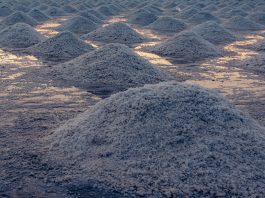S34I is an innovative European project that seeks to increase Europe’s autonomy in raw materials resources by utilising advanced data-driven techniques for analysing Earth observation (EO) data.
The backbone of Europe’s economy lies in its raw materials. They provide a robust industrial foundation, producing a diverse range of goods and applications that are a part of our daily lives and modern technologies. However, the availability of certain raw materials remains a growing concern both within the EU and throughout the world. It’s essential to ensure reliable and unrestricted access to these materials to maintain a stable and flourishing economy.
European raw materials are crucial
Europe has always been dependent on other regions for its raw materials, which makes it vulnerable. However, a new project called S34I, which was launched in January 2023 and co-ordinated by the University of Oporto, aims to increase Europe’s autonomy in raw materials resources by utilising advanced data-driven techniques for analysing Earth Observation (EO) data.
The project leverages Copernicus and other satellite sensors (including optical and radar) for data collection, while other platforms like airborne, low altitude platforms, ground-based, in-situ techniques/methods, and fieldwork are used to complement Copernicus data or for calibration and validation purposes. The S34I project’s primary focus is on systematically exploring minerals and continually monitoring extraction, closure, and post-closure activities to improve European knowledge and autonomy on raw materials resources. Additionally, the project seeks to improve social acceptance of mining (SLO) and promote better legislation.
S34I is developing technical experiments and pilot validations/demonstrations for six pilot use cases, including Onshore Exploration, Shallow Water Exploration, Extraction, and Closure/Post-Closure:
- Onshore Exploration (Áramo, Spain): Using artificial intelligence (AI)techniques like support vector machine (SVM), random forest (RF), and artificial neural networks (ANN), the project aims to map potential Cobalt (Co) target areas using various satellite-based datasets. This includes leveraging self-organising maps (SOM) for preprocessing exploration datasets and combining geological and remote sensing models to detect hydrothermal alterations associated with Co.
- Shallow Water Exploration (Ria de Vigo, Spain): AI/ML techniques are utilised to post-process UHI data to establish a spectral library for ground-truthing and correlate it with onshore EO data. Geological studies help in identifying promising areas for placer deposit occurrences.
- Extraction (Gummern, Austria): The project aims to improve volume mapping of mining waste deposits and monitor ground instability using techniques like Structure from Motion (SfM) photogrammetry and InSAR methods, respectively. Additionally, mineral stockpile volume estimation is performed using satellite photogrammetry and 3D-stereo images.
- Closure/Post-Closure (Lausitz, Germany and Keretti-Outokumpu, Finland): Advanced AI techniques such as SBAS-InSAR and predictive modelling are employed for ground instability mapping and Acid Mine Drainage (AMD) prediction.

Earth observation data is key
The project’s methodology involves conducting multi-scale and multi-platform analysis of EO data, which is harmonised to meet EU data quality standards. Prototype processing pipelines are currently under development for three service categories: mapping raw materials deposits, providing early warnings for risk reduction, and monitoring environmental changes.
S34I uses advanced AI techniques, such as SBAS-InSAR and predictive modelling, to create a comprehensive view of ground instability mapping and Acid Mine Drainage (AMD) prediction. The project is also paying special attention to enhancing geological integration at the land-sea interface and ensuring open access to research datasets.
Ultimately, the project aims to demonstrate the value of its results to stakeholders by promoting secure and sustainable raw materials supply to Europe while enhancing resilience and reducing dependence on non-EU sources.
S34I is the perfect example of how innovation and technology can help boost Europe’s self-reliance and ensure that it remains a leader in raw materials resources.
Contributors
Ana Cláudia Teodoro
Professor at the Faculty of Sciences of the University of Porto – S34I Project Coordinator
Krištof Oštir
Professor at University of Ljubljana, Faculty of Civil and Geodetic Engineering
Matija Gerčer
B.Sc. and with. geod. (UN) University of Ljubljana, Faculty of Civil and Geodetic Engineering – S34I Project Partner
Alicia García López
Communication & Dissemination responsible
Iberian Sustainable Mining Cluster – S34I Project
Please note, this article will also appear in the 18th edition of our quarterly publication.









